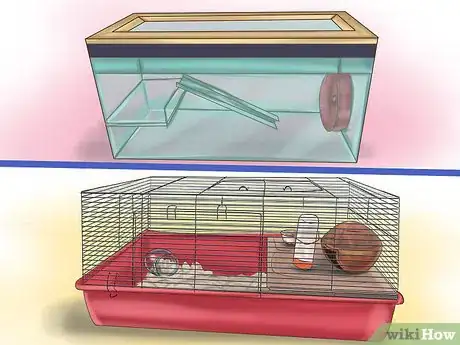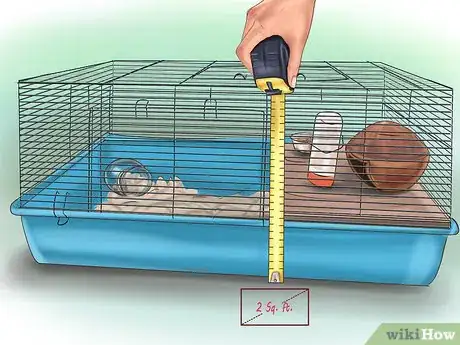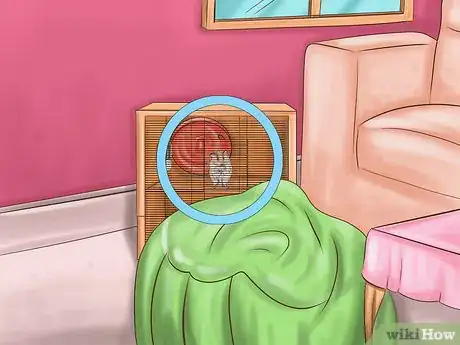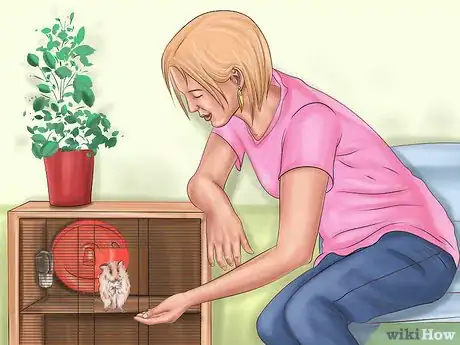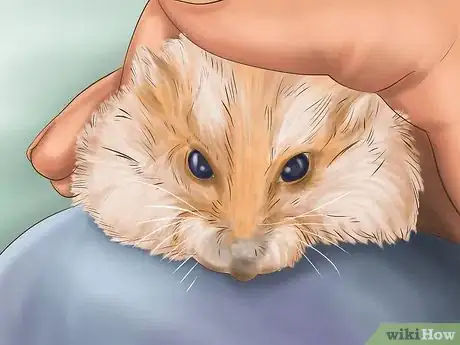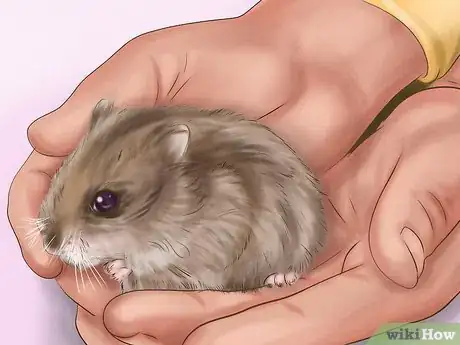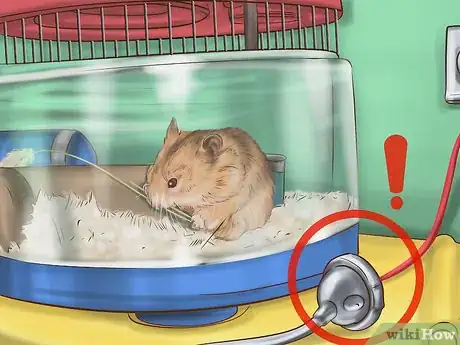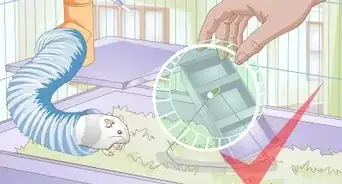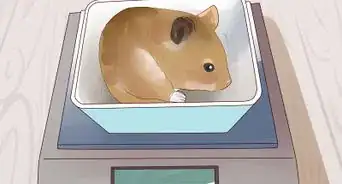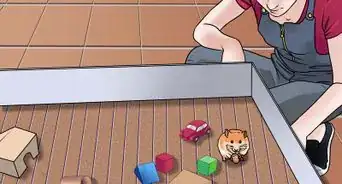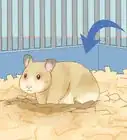This article was co-authored by Pippa Elliott, MRCVS. Dr. Elliott, BVMS, MRCVS is a veterinarian with over 30 years of experience in veterinary surgery and companion animal practice. She graduated from the University of Glasgow in 1987 with a degree in veterinary medicine and surgery. She has worked at the same animal clinic in her hometown for over 20 years.
This article has been viewed 111,200 times.
Before you can handle your hamster, you will need to bond and tame it. Bonding with your hamster before you try to hold it will allow your hamster to feel comfortable and prevent any biting caused by fear or stress. Work slowly and be patient as you build a bond with your hamster.
Steps
Providing a Fun and Comfortable Cage
-
1Pick a cage type. When looking for a hamster cage, you will come across a few different types of cages. Each type of cage will have its own benefits and drawbacks. Review the following list to get an idea of which type of cage might work best for you and your new hamster:[1]
- Mesh or wire cages are easy to clean and have great ventilation. However, they may have small openings that can let smaller hamsters escape.
- Glass aquariums can provide a safe and secure home for your hamster. However, these cages are more difficult to clean.
- Plastic habitats provide modular compartments and tunnels that can be very engaging for your hamster. The down-side of plastic habitats is that they have poor ventilation and are very difficult to clean.
-
2Get the right size cage. Your hamster will want plenty of room to run, sleep, eat, and play in. You will have to find a cage that is also big enough to allow your hamster to nest and burrow in. Remember to leave room for any toys or exercise equipment that you plan on placing in the cage.[2]
- You will need a cage that is at least a minimum of two square feet.
Advertisement -
3Find the best spot for the cage. Once you have a cage for your hamster, you will need to find a good spot in your home for that cage. You will need to find a place in your home for the cage that meets the following criteria:[3]
- The ideal temperature for your hamster will be between 65-75 degrees Fahrenheit.
- Avoid placing the cage next to any strong drafts, heat sources, or direct sunlight.
- Put the cage in a quite place. Your hamster won't feel comfortable if they are disturbed often or are in a noisy environment.
Handling Your Hamster
-
1Allow your new hamster to adjust. If you have just brought a new hamster home, you will want to allow it time to become used to its cage and new environment. By letting your hamster adjust to its new home, it will be more relaxed and more open to bonding with you.[4]
- It can take up to three weeks to bond with your hamster, so be patient and work slowly.
-
2Introduce yourself to your hamster. Start approaching the cage more often and introducing yourself to your hamster. Don't try to work too quickly. Allow your hamster to see and hear you without touching or handling it.[5]
- Let the hamster know you are nearby. Try talking to it as you work to introduce yourself.
- You can try placing your hand in the cage, but don't try to touch the hamster.
- Allow your hamster to get used to your scent and presence before any handling is attempted.
-
3Try petting your hamster. While your hamster is eating its food or a tasty treat you left it, you can try petting your hamster. By showing your hamster that your touch is nothing to fear, it will eventually relax and enjoy your handling it.
- It may take a few days until your hamster is used to you touching it.
- Don't try to pick up the hamster at this point.
- If your hamster gets nervous and wants to hide, let it.
-
4Start hand feeding your hamster. After your hamster has been allowed time to acclimate to both its new home and owner, you can begin to hand feed it. Work towards this goal slowly and never force any interaction between you and your hamster.[6]
- Start by placing your hand in the cage without food. Don't try to touch your hamster, instead, allow it to investigate your hand on its own.
- Add a treat to your hand when you put it in the cage. Allow your hamster to investigate and take the treat if it wants to.
-
5Try picking your hamster up. After your hamster seems used to your presence and touch, you can try to pick your hamster up. Work slowly and gently as you do so, watching for any signs of stress or fear from your hamster.
- Never lift your hamster by the tail or the front legs as this will only cause injury.
- Make sure you cup your hands and support the entire body of the hamster.
- Try to let your hamster climb up and onto your hand before lifting it out of the cage.
- Any pain or discomfort felt by your hamster will undo any bond and cause your hamster to fear you.
- Make sure your hamster won't get hurt from falling if it escapes from your hand.
Playing Outside the Cage
-
1Pick your hamster up and hold it properly. After your hamster has been tamed and is comfortable with you picking it up, you can take it out of the cage to play. As always, be careful when holding your hamster to prevent injury or stress.[7]
- Never squeeze your hamster as you hold it.
- Hold your hamster close to the ground or near your lap in case it jumps from your hands.
- If your hamster bites you, it may be tired and time to return to the cage.
-
2Check for dangers. Before you let your hamster out to explore and get exercise, you will need to check the room for any hazards that may be present. Hamsters can move quickly and are easily injured, so you will need to keep a close eye on them as they play.[8]
- Keep other pets or animals out of the room.
- Look for any electrical cords that your hamster might chew.
- Block off any small spaces that your hamster might squeeze into and become stuck.
Expert Q&A
-
QuestionHow do you take care of a hamster?
 Melissa Nelson, DVM, PhDDr. Nelson is a Veterinarian who specializes in Companion and Large Animal Medicine in Minnesota, where she has over 18 years of experience as a veterinarian in a rural clinic. She received her Doctor of Veterinary Medicine from the University of Minnesota in 1998.
Melissa Nelson, DVM, PhDDr. Nelson is a Veterinarian who specializes in Companion and Large Animal Medicine in Minnesota, where she has over 18 years of experience as a veterinarian in a rural clinic. She received her Doctor of Veterinary Medicine from the University of Minnesota in 1998.
Veterinarian They need appropriate hamster food, an escape proof/predator proof cage, clean water, daily food, and exercise.
They need appropriate hamster food, an escape proof/predator proof cage, clean water, daily food, and exercise. -
QuestionCan you train a hamster to do tricks?
 Melissa Nelson, DVM, PhDDr. Nelson is a Veterinarian who specializes in Companion and Large Animal Medicine in Minnesota, where she has over 18 years of experience as a veterinarian in a rural clinic. She received her Doctor of Veterinary Medicine from the University of Minnesota in 1998.
Melissa Nelson, DVM, PhDDr. Nelson is a Veterinarian who specializes in Companion and Large Animal Medicine in Minnesota, where she has over 18 years of experience as a veterinarian in a rural clinic. She received her Doctor of Veterinary Medicine from the University of Minnesota in 1998.
Veterinarian Yes they can learn simple tricks, usually by rewarding them with treats. Good treats are a piece of their food or a low sugar vegetables.
Yes they can learn simple tricks, usually by rewarding them with treats. Good treats are a piece of their food or a low sugar vegetables.
Warnings
- If your hamster bites you, clean and sterilize the cut properly.⧼thumbs_response⧽
- Hamsters are fragile and can be injured easily. Always handle with care.⧼thumbs_response⧽
- Always wash your hands, before and after, handling your hamster.⧼thumbs_response⧽
References
- ↑ http://www.humanesociety.org/animals/hamsters/tips/hamster_housing.html?credit=web_id139895439#
- ↑ http://www.humanesociety.org/animals/hamsters/tips/hamster_housing.html?credit=web_id139895439#
- ↑ http://www.humanesociety.org/animals/hamsters/tips/hamster_housing.html?credit=web_id139895439#
- ↑ http://animals.mom.me/bond-hamster-1107.html
- ↑ http://animals.mom.me/bond-hamster-1107.html
- ↑ http://animals.mom.me/bond-hamster-1107.html
- ↑ http://www.smallanimalchannel.com/hamsters/hamster-behavior/hamster-out-of-cage.aspx
- ↑ http://www.smallanimalchannel.com/hamsters/hamster-behavior/hamster-out-of-cage.aspx
- ↑ http://www.2ndchance.info/hamsterbite.htm
About This Article
To create a bond with your hamster, give your new pet a little time to adjust once you bring it home. Next, start talking to your hamster so that it gets used to your voice and presence. Then, put your hand in the cage and let the hamster sniff and investigate you. Gradually work your way up to hand-feeding and gentle petting. Once your hamster seems comfortable with petting, pick it up regularly and let it play outside of its cage to strengthen your bond. For more tips from our Veterinary co-author, like how to create an ideal habitat for your hamster, read on!
